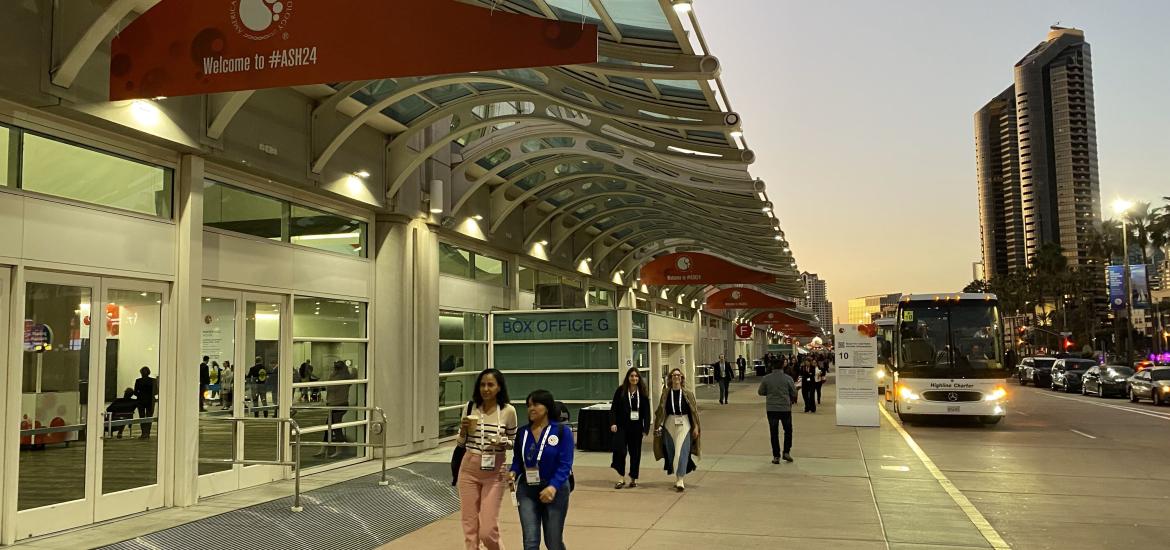
ASH 2024 – Sumitomo joins the menin party
Enzomenib might be the most promising agent so far, on a cross-trial basis.
Enzomenib might be the most promising agent so far, on a cross-trial basis.

Syndax recently got approval for the first menin inhibitor, Revuforj, but plenty of other groups are trying to get a piece of the action. And the latest entrant, Sumitomo, presented data at ASH on Saturday suggesting that it might have the most promising agent of all.
The company’s enzomenib has shown, albeit on a cross-trial basis, the most impressive response rate in NPM1m relapsed/refractory acute leukaemia, and it also looks competitive in KMT2Ar disease. The Japanese company might have stolen some thunder from Johnson & Johnson, which also reported results with its contender, bleximenib, that also looked promising.
Importantly, both enzomenib and bleximenib appear largely to avoid the QTc prolongation that has caused concern with Revuforj. This also doesn’t seem to be an issue with Kura’s contender, ziftomenib, which is no longer being developed in relapsed/refractory KMT2Ar leukaemia, the genetic subset where Revuforj has just got the go ahead based on Augment-101.
Meanwhile, differentiation syndrome is emerging as a class effect for menin inhibitors. Both enzomenib and bleximenib are associated with this adverse event, but seemingly at lower levels than Revuforj.
Cross-trial comparison of menin inhibitors in r/r acute leukaemia
Enzomenib | Bleximenib | Revuforj | ||||
|---|---|---|---|---|---|---|
| Company | Sumitomo | J&J | Syndax | |||
| Trial | Ph1/2 DSP-5336-101 | Ph1/2 Camelot-1 | Ph1/2 Augment-101 | |||
| Cutoff | 22 Oct 2024 | Oct 2024 | 29 Feb 2024 | 18 Sep 2024 | ||
| Subgroup | KMT2r | NPM1m | KMT2r | NPM1m | KMT2r | NPM1m |
| CR + CRh | 30% (7/23) | 47% (8/17) | 33% (3/9) | 33% (4/12) | 23% (22/97) | 23% (15/64) |
| ≥Gr3 QTc prolongation | 1% (1/84) | 3% (1/31) | 13% (15/116) | 21% (18/84) | ||
| Differentiation syndrome | 11% (9/84) | 19% (6/31) | 27% (31/116) | 13% (11/84)* | ||
| Source | ASH 2024 | ASH 2024 | ASH 2024 | Nov 2024 PR | ||
Notes: *gr3+ only given; enzomenib efficacy data at 200mg & 300mg BID only; bleximenib efficacy & safety data at 90/100mg BID only. Source: ASH 2024 & company presentation.
There could be lingering toxicity doubts about J&J’s bleximenib, however. Dr Emma Searle of the UK's Christie NHS Foundation Trust, presenting the data from the phase 1/2 Camelot-1 trial, concluded that QTc prolongation hadn’t been identified as a safety signal to date, but the ASH abstract detailed one grade 3 case of this side effect as a dose-limiting toxicity, albeit in a patient with “significant cardiac comorbidities”.
When asked about this, J&J noted that no other cases had occurred during the trial.
There were also two differentiation syndrome deaths with bleximenib, one at 90/100mg twice daily; J&J has selected a 100mg twice-daily dose to take into the phase 2 portion of Camelot-1.
Not the same?
Meanwhile, Dr Joshua Zeidner of the University of North Carolina Lineberger Comprehensive Cancer Center claimed, when presenting the enzomenib data, that not all menin inhibitors were the same.
With 200mg and 300mg twice-daily dosing the Sumitomo project has certainly produced impressive efficacy and particularly low rates of QTc prolongation and differentiation syndrome. Zeidner noted there were no deaths or permanent discontinuations of enzomenib due to the latter.
The company is still trying to find its optimal dose, and is now testing 400mg twice-daily; however, Zeidner noted that data here were too early to report, and would come at a future meeting.
Ahead of ASH, J&J told ApexOnco that it believed it had the best-in-class menin inhibitor. Given the data just presented, Sumitomo might have other ideas.
3586













